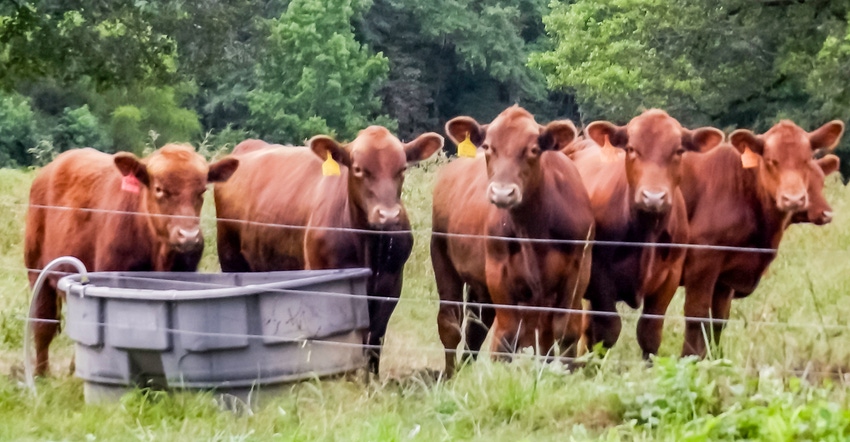May 25, 2021

The fences have been checked. Mineral tubs have been laid out. It’s time for cattle to move to grass.
But, before cattle producers start hauling cattle to pasture, they need to check the water sources for the herd, says Ronald Graber, Kansas State University watershed specialist for the south-central region.
“Water is the most important nutrient,” he said. “Without water, we certainly aren’t going to have a very productive animal or productive herd.” Graber spoke April 29 during a K-State Cattle Conversations webinar. He says cattlemen need to consider several factors when setting up a water source for their herds.
Calculate water intake
First step is to calculate how much water will be needed per head per day. The rule of thumb is, calves and feeder calves will consume about 10 gallons per head per day, while mature lactating cows will take up to 15 gallons per head per day.
“If your cattle are in a drylot and you’re feeding dry hay, cows may consume the most water because they are not getting it from their feed,” Graber said. “Cattle consume a lot of water even in the winter with dry hay consumption.
“In winter, that lactating cow may be just at 11 gallons per day,” Graber said. “In the middle of the summer, that could jump up to 17 gallons per day.” Simple math for a herd of 50 beef cows with 300-pound calves at their sides would result in about 979 gallons for the herd every day.
“That’s a big tank,” Graber said. “How much do they take in when they go to water? Does the whole herd drink at one time and then leave? Do they drink once a day or twice a day? We need to be able to have enough water in there.” He added that a water pump also needs to be able to refill the holding tank in a timely fashion when the whole herd is drinking.
Location
Another rule of thumb when locating water sources is to put them in a pasture where cattle need to walk less than 1 to 1.5 miles to their water, he added. And if it’s rough pasture, they shouldn’t walk more than one-half to three-quarters of a mile, preferably less.
“Locate those tanks in a flat, upland location,” Graber said. Be sure to consider streams, and protect the water quality from cattle loitering in riparian areas or in the stream itself, he added.
Water sites work like salt and mineral sites in a pasture, too, by encouraging cattle to graze parts of a pasture that might not be grazed often. And, cattle producers should consider if there’s shade nearby for summer grazing, or if the water source is in the sun for winter grazing.
Water quality
The health and performance of your calf crop is directly impacted by water quality, Graber emphasized.
“Quality and quantity of water may add 50 pounds to a calf’s weaning weight,” he said. “That’s real dollars.”
First, cattle won’t drink poor-quality water. That decreased intake sets calves back in their feeding intake. Another rule of thumb is that a calf will require about 5 gallons of water for every 1 pound of feed intake.
Cattlemen should also test their water for contaminants, such as minerals, total dissolved solids, coliform from manure, microorganisms, nitrates, algae and more. These can directly cause health problems in young calves.
Local Extension offices have resources for cattle producers looking to develop or improve their water resources in their pastures, Graber said.
You May Also Like




